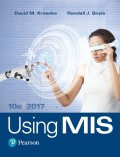
EBK USING MIS
10th Edition
ISBN: 8220103633642
Author: KROENKE
Publisher: YUZU
expand_more
expand_more
format_list_bulleted
Expert Solution & Answer
Chapter 11.5, Problem 11.4ARQ
Explanation of Solution
User rights:
- Computer hardware and
programs that are required to perform your job proficiently.- User has the right to access all the resources like computer hardware and programs required, to complete his/her tasks successfully.
- Reliable network and internet connections:
- Users have the right to use the reliable network connection which means there will be no problems while using it.
- A secure computing environment:
- Organization should take care about the security issues of the user’s computer and files. It should ask users to take the actions required to protect the files, if required.
- Protection from viruses, worms, and other threats:
- It’s the organization’s duty to take care about the safety of the user’s files and computer. Thus, it is user’s right to have their files and computer protected from the viruses, worms, and other threats.
- Contribution to requirements for new system, features and functions:
- Users have the right to participate in the meetings conducted to discuss about the new system requirements. If not directly then through a delegate.
- Reliable systems development and maintenance:
- Users have a right to have reliable systems development and maintenance. They can experience schedule slippage for a month or 2 but need not face it for 6 months or more. This shows the incompetent systems development.
- Prompt attention to problems, concerns, and complaints:
- Users have the right to receive immediate response towards the problems and concerns from the organization. If not directly, then the users should be provided with some means through which they can report the issues or at least get their complaints registered in IS department.
- Properly prioritized problem fixes and resolutions:
- Users can have their problems get resolved with established priorities.
- Effective training:
- Users have the right to get trained in the organization so that they can perform the particular task they want to do. Organization should train the users in a format and on a schedule that is suitable for the user.
User responsibilities:
- Learn basic computer skills:
- Users have the responsibility to have the basic computer skills. They cannot expect hand-holding for basic operations.
- Learn standard techniques and procedures for the applications and use:
- Users should learn the techniques and procedures required to use the applications...
Expert Solution & Answer
Want to see the full answer?
Check out a sample textbook solution
Students have asked these similar questions
⚫ your circuit diagrams for your basic bricks, such as AND, OR, XOR gates and 1 bit multiplexers,
⚫ your circuit diagrams for your extended full adder, designed in Section 1 and
⚫ your circuit diagrams for your 8-bit arithmetical-logical unit, designed in Section 2.
1 An Extended Full Adder
In this Section, we are going to design an extended full adder circuit (EFA). That EFA takes 6 one bit inputs: aj, bj,
Cin, Tin, t₁ and to. Depending on the four possible combinations of values on t₁ and to, the EFA produces 3 one bit
outputs: sj, Cout and rout.
The EFA can be specified in principle by a truth table with 26 = 64 entries and 3 outputs. However, as the EFA
ignores certain inputs in certain cases, it is easier to work with the following overview specification, depending only
on t₁ and to in the first place:
t₁ to Description
00
Output Relationship
Ignored
Inputs
Addition Mode
2 Coutsjaj + bj + Cin, Tout= 0
Tin
0 1
Shift Left Mode
Sj = Cin,
Cout=bj, rout = 0
rin, aj
10
1 1
Shift Right…
Show the correct stereochemistry
when needed!!
mechanism:
mechanism:
Show the correct stereochemistry when needed!!
Br
NaOPh
diethyl ether
substitution
In java
Chapter 11 Solutions
EBK USING MIS
Ch. 11.2 - Prob. 1MDQCh. 11.2 - Prob. 2MDQCh. 11.2 - Prob. 3MDQCh. 11.2 - Prob. 4MDQCh. 11.2 - Prob. 5MDQCh. 11.3 - Prob. 1EGDQCh. 11.3 - Prob. 2EGDQCh. 11.3 - Prob. 3EGDQCh. 11.3 - Prob. 4EGDQCh. 11.5 - Prob. 1SGDQ
Ch. 11.5 - Prob. 2SGDQCh. 11.5 - Prob. 3SGDQCh. 11.5 - Prob. 4SGDQCh. 11.5 - Prob. 11.1ARQCh. 11.5 - How do organizations plan the use of IS? Explain...Ch. 11.5 - Prob. 11.3ARQCh. 11.5 - Prob. 11.4ARQCh. 11.5 - Prob. 11.5ARQCh. 11 - Prob. 11.1UYKCh. 11 - Prob. 11.2UYKCh. 11 - Prob. 11.3UYKCh. 11 - Prob. 11.8CE11Ch. 11 - Prob. 11.11CS11Ch. 11 - Prob. 11.12CS11Ch. 11 - Prob. 11.13CS11Ch. 11 - Prob. 11.14CS11Ch. 11 - Prob. 11.15CS11Ch. 11 - Prob. 11.16CS11Ch. 11 - Prob. 11.17CS11Ch. 11 - Prob. 11.18MML
Knowledge Booster
Similar questions
- KeanPerson #keanld:int #keanEmail:String #firstName:String #lastName: String KeanAlumni -yearOfGraduation: int - employmentStatus: String + KeanPerson() + KeanPerson(keanld: int, keanEmail: String, firstName: String, lastName: String) + getKeanld(): int + getKeanEmail(): String +getFirstName(): String + getLastName(): String + setFirstName(firstName: String): void + setLastName(lastName: String): void +toString(): String +getParkingRate(): double + KeanAlumni() + KeanAlumni(keanld: int, keanEmail: String, firstName: String, lastName: String, yearOfGraduation: int, employmentStatus: String) +getYearOfGraduation(): int + setYearOfGraduation(yearOfGraduation: int): void +toString(): String +getParkingRate(): double In this question, write Java code to Create and Test the superclass: Abstract KeanPerson and a subclass of the KeanPerson: KeanAlumni. Task 1: Implement Abstract Class KeanPerson using UML (10 points) • Four data fields • Two constructors (1 default and 1 constructor with all…arrow_forwardPlz correct answer by best experts...??arrow_forwardQ3) using the following image matrix a- b- 12345 6 7 8 9 10 11 12 13 14 15 1617181920 21 22 23 24 25 Using direct chaotic one dimension method to convert the plain text to stego text (hello ahmed)? Using direct chaotic two-dimension method to convert the plain text to stego text?arrow_forward
- : The Multithreaded Cook In this lab, we'll practice multithreading. Using Semaphores for synchronization, implement a multithreaded cook that performs the following recipe, with each task being contained in a single Thread: 1. Task 1: Cut onions. a. Waits for none. b. Signals Task 4 2. Task 2: Mince meat. a. Waits for none b. Signals Task 4 3. Task 3: Slice aubergines. a. Waits for none b. Signals Task 6 4. Task 4: Make sauce. a. Waits for Task 1, and 2 b. Signals Task 6 5. Task 5: Finished Bechamel. a. Waits for none b. Signals Task 7 6. Task 6: Layout the layers. a. Waits for Task 3, and 4 b. Signals Task 7 7. Task 7: Put Bechamel and Cheese. a. Waits for Task 5, and 6 b. Signals Task 9 8. Task 8: Turn on oven. a. Waits for none b. Signals Task 9 9. Task 9: Cook. a. Waits for Task 7, and 8 b. Signals none At the start of each task (once all Semaphores have been acquired), print out a string of the task you are starting, sleep for 2-11 seconds, then print out a string saying that you…arrow_forwardProgramming Problems 9.28 Assume that a system has a 32-bit virtual address with a 4-KB page size. Write a C program that is passed a virtual address (in decimal) on the command line and have it output the page number and offset for the given address. As an example, your program would run as follows: ./addresses 19986 Your program would output: The address 19986 contains: page number = 4 offset = 3602 Writing this program will require using the appropriate data type to store 32 bits. We encourage you to use unsigned data types as well. Programming Projects Contiguous Memory Allocation In Section 9.2, we presented different algorithms for contiguous memory allo- cation. This project will involve managing a contiguous region of memory of size MAX where addresses may range from 0 ... MAX - 1. Your program must respond to four different requests: 1. Request for a contiguous block of memory 2. Release of a contiguous block of memory 3. Compact unused holes of memory into one single block 4.…arrow_forwardusing r languagearrow_forward
- Programming Problems 9.28 Assume that a system has a 32-bit virtual address with a 4-KB page size. Write a C program that is passed a virtual address (in decimal) on the command line and have it output the page number and offset for the given address. As an example, your program would run as follows: ./addresses 19986 Your program would output: The address 19986 contains: page number = 4 offset = 3602 Writing this program will require using the appropriate data type to store 32 bits. We encourage you to use unsigned data types as well. Programming Projects Contiguous Memory Allocation In Section 9.2, we presented different algorithms for contiguous memory allo- cation. This project will involve managing a contiguous region of memory of size MAX where addresses may range from 0 ... MAX - 1. Your program must respond to four different requests: 1. Request for a contiguous block of memory 2. Release of a contiguous block of memory 3. Compact unused holes of memory into one single block 4.…arrow_forwardusing r languagearrow_forwardWrite a function to compute a Monte Carlo estimate of the Beta(3, 3) cdf, and use the function to estimate F(x) for x = 0.1,0.2,...,0.9. Compare the estimates with the values returned by the pbeta function in R.arrow_forward
arrow_back_ios
SEE MORE QUESTIONS
arrow_forward_ios
Recommended textbooks for you
 Database Systems: Design, Implementation, & Manag...Computer ScienceISBN:9781305627482Author:Carlos Coronel, Steven MorrisPublisher:Cengage Learning
Database Systems: Design, Implementation, & Manag...Computer ScienceISBN:9781305627482Author:Carlos Coronel, Steven MorrisPublisher:Cengage Learning Database Systems: Design, Implementation, & Manag...Computer ScienceISBN:9781285196145Author:Steven, Steven Morris, Carlos Coronel, Carlos, Coronel, Carlos; Morris, Carlos Coronel and Steven Morris, Carlos Coronel; Steven Morris, Steven Morris; Carlos CoronelPublisher:Cengage Learning
Database Systems: Design, Implementation, & Manag...Computer ScienceISBN:9781285196145Author:Steven, Steven Morris, Carlos Coronel, Carlos, Coronel, Carlos; Morris, Carlos Coronel and Steven Morris, Carlos Coronel; Steven Morris, Steven Morris; Carlos CoronelPublisher:Cengage Learning Management Of Information SecurityComputer ScienceISBN:9781337405713Author:WHITMAN, Michael.Publisher:Cengage Learning,
Management Of Information SecurityComputer ScienceISBN:9781337405713Author:WHITMAN, Michael.Publisher:Cengage Learning, Systems ArchitectureComputer ScienceISBN:9781305080195Author:Stephen D. BurdPublisher:Cengage Learning
Systems ArchitectureComputer ScienceISBN:9781305080195Author:Stephen D. BurdPublisher:Cengage Learning A+ Guide To It Technical SupportComputer ScienceISBN:9780357108291Author:ANDREWS, Jean.Publisher:Cengage,
A+ Guide To It Technical SupportComputer ScienceISBN:9780357108291Author:ANDREWS, Jean.Publisher:Cengage, Fundamentals of Information SystemsComputer ScienceISBN:9781337097536Author:Ralph Stair, George ReynoldsPublisher:Cengage Learning
Fundamentals of Information SystemsComputer ScienceISBN:9781337097536Author:Ralph Stair, George ReynoldsPublisher:Cengage Learning

Database Systems: Design, Implementation, & Manag...
Computer Science
ISBN:9781305627482
Author:Carlos Coronel, Steven Morris
Publisher:Cengage Learning

Database Systems: Design, Implementation, & Manag...
Computer Science
ISBN:9781285196145
Author:Steven, Steven Morris, Carlos Coronel, Carlos, Coronel, Carlos; Morris, Carlos Coronel and Steven Morris, Carlos Coronel; Steven Morris, Steven Morris; Carlos Coronel
Publisher:Cengage Learning

Management Of Information Security
Computer Science
ISBN:9781337405713
Author:WHITMAN, Michael.
Publisher:Cengage Learning,

Systems Architecture
Computer Science
ISBN:9781305080195
Author:Stephen D. Burd
Publisher:Cengage Learning

A+ Guide To It Technical Support
Computer Science
ISBN:9780357108291
Author:ANDREWS, Jean.
Publisher:Cengage,

Fundamentals of Information Systems
Computer Science
ISBN:9781337097536
Author:Ralph Stair, George Reynolds
Publisher:Cengage Learning